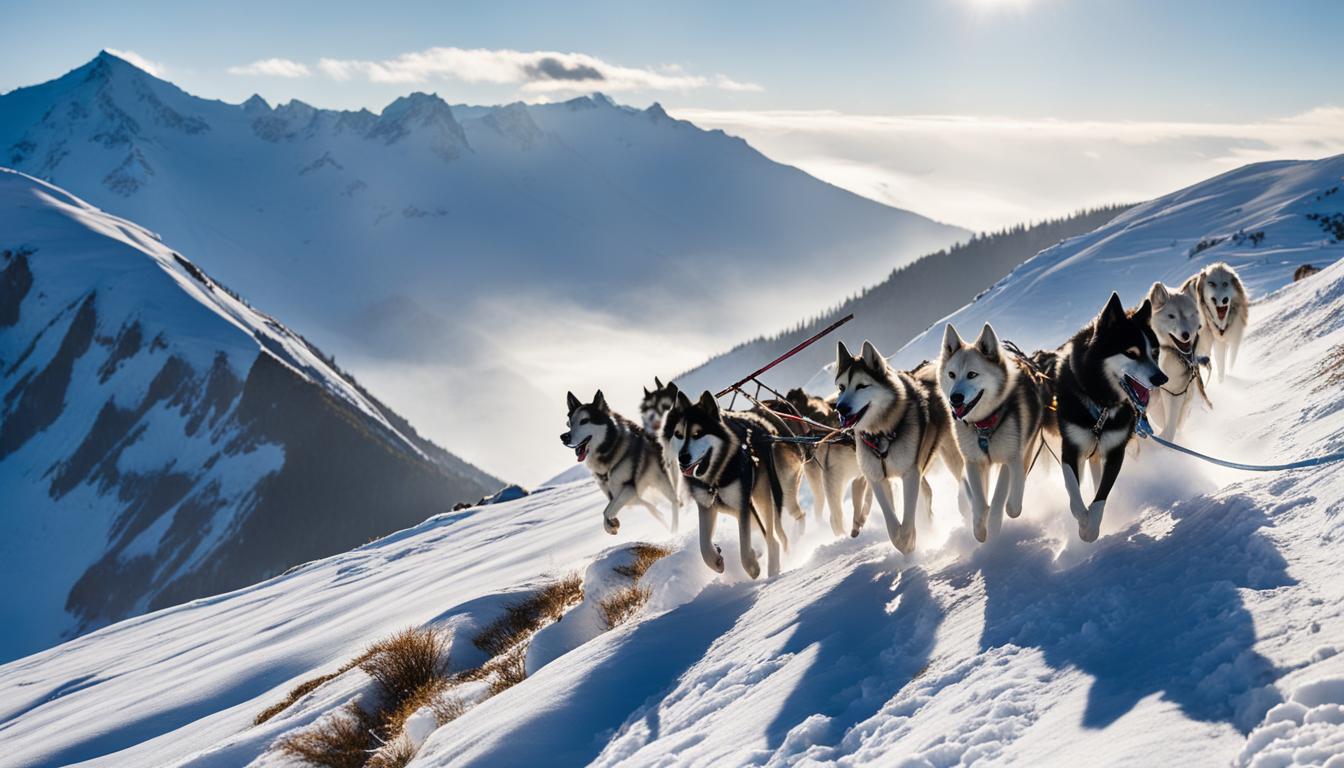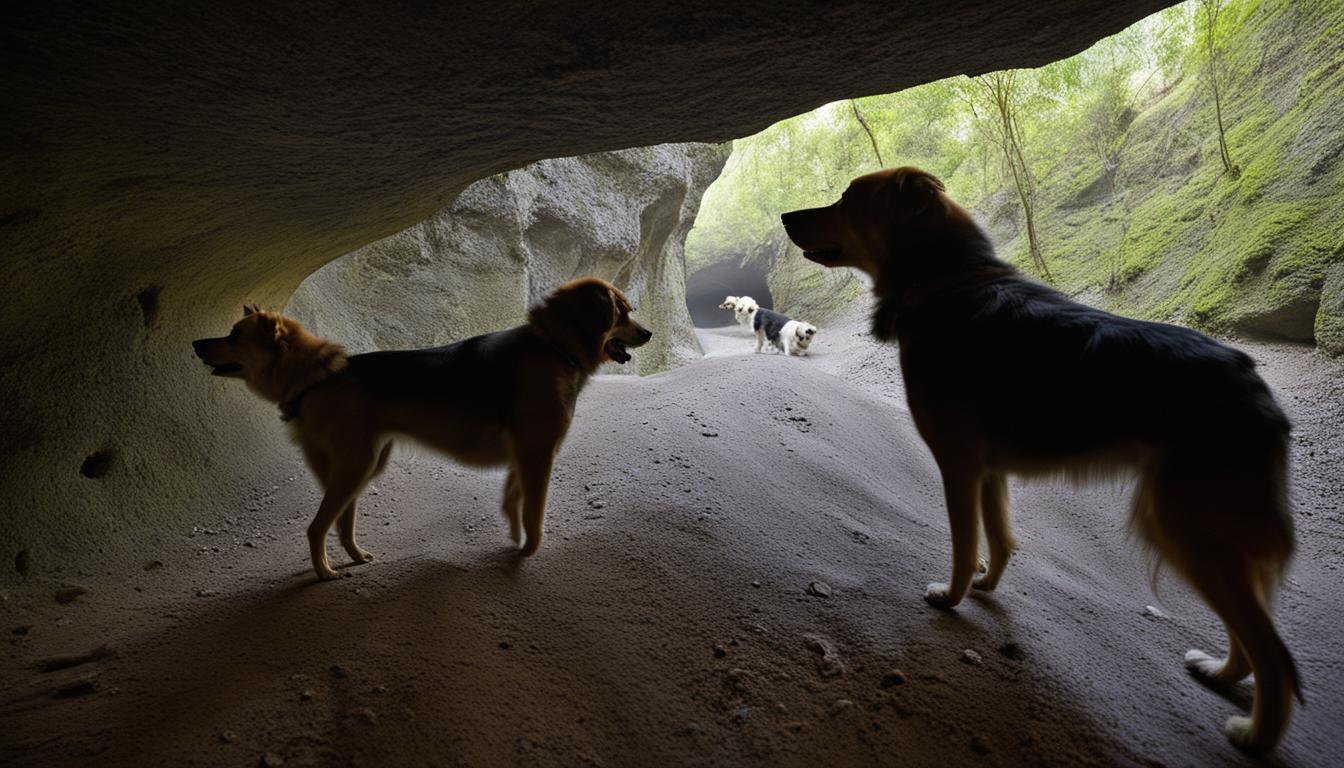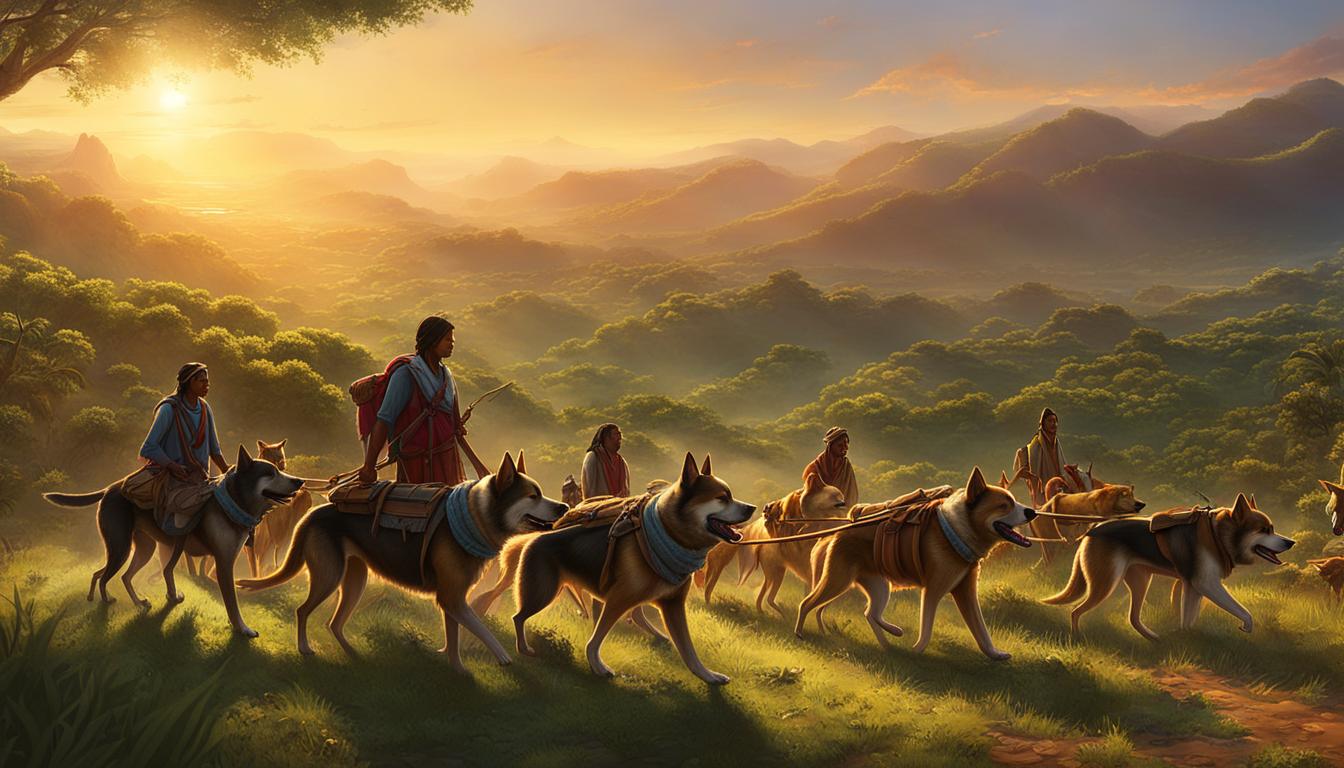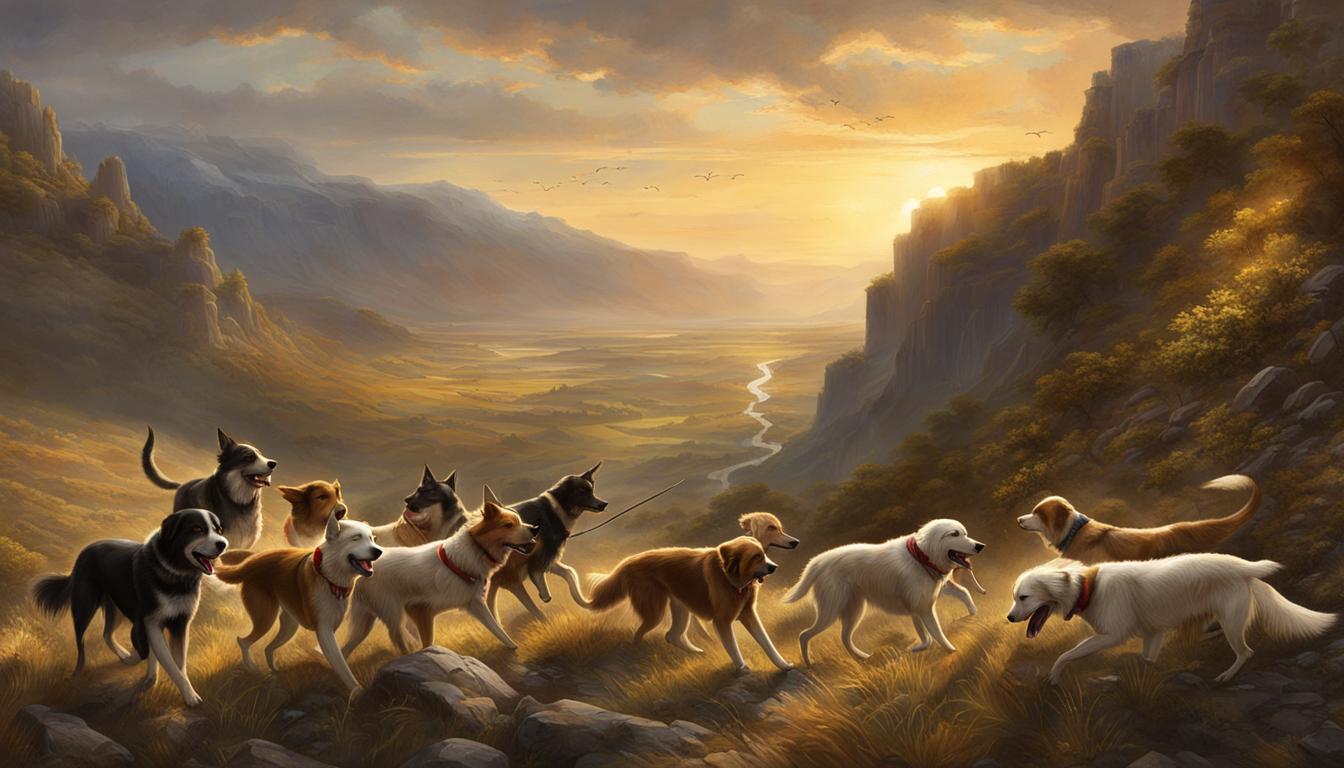Welcome to our fascinating exploration of the historical significance of dogs in South American Andean expeditions! These loyal and intelligent creatures have been more than just furry companions; they have been the guiding stars for countless explorers, helping them navigate the majestic peaks and treacherous paths of the Andes Mountains.
From the early days of South American exploration to the present, dogs have played an integral role in the success and safety of adventurers. Their innate abilities to read the terrain, locate safe routes, and provide early warnings of danger have made them invaluable partners in the pursuit of discovery.
Key Takeaways:
- Dogs have been trusted companions and guides in South American Andean expeditions.
- They possess a keen sense of smell and intuition, enabling them to navigate the challenging terrain of the Andes Mountains.
- Canines have assisted explorers in locating safe routes, finding food and water sources, and providing warnings of potential dangers.
- The use of dogs in Andean expeditions has evolved over time, with different breeds and crossbreeds playing various roles.
- Explorers have relied on dogs to guide and protect them in their quests for exploration and adventure.
The Historical Significance of Dogs in Andes Expeditions
In the realm of Andean expeditions, dogs have played a vital role throughout history. These faithful and intrepid canines have accompanied explorers on their adventurous journeys, serving as trusted companions and guardians in the rugged terrain of the South American mountains. Their presence is an integral part of the historical fabric of Andean travels, providing invaluable support to those who dared to venture into the unknown.
Whether it was the Inca civilization exploring new territories or European conquerors seeking riches, dogs have been by their side, sharing both the triumphs and challenges. These canine companions have demonstrated unwavering loyalty, guiding their human counterparts through treacherous paths, alerting them to potential dangers, and offering warmth and comfort in the harsh mountain climate.
“Dogs have been man’s best friend in Andean expeditions, serving as trusty guides and protectors throughout history.”
Their remarkable ability to navigate the Andean terrain has been instrumental in the success and survival of explorers. With their acute senses, dogs have been able to sniff out safe routes, locate vital resources such as food and water, and provide early warnings of potential hazards. Their role in the trials and triumphs of South American mountain exploration cannot be overstated.
Table: Dogs in Historic Andean Travels
| Expedition | Explorers | Role of Dogs |
|---|---|---|
| Inca Expansion | Inca civilization | Assistance in territorial exploration and transportation |
| Spanish Conquest | European conquistadors | Guidance in search of El Dorado and protection against indigenous resistance |
| Scientific Expeditions | Modern explorers and researchers | Detection of archaeological sites and ecological discoveries |
These faithful companions have left an indelible mark on the history of Andean expeditions. From ancient civilizations to contemporary scientific endeavors, the bond between humans and dogs has been a source of strength, companionship, and survival. The legacy of their contributions continues to inspire and remind us of the shared journey we embark upon with our loyal four-legged friends.

| Canine Roles in South American Mountain Exploration | Key Contributions |
|---|---|
| Navigators and Guides | Using their keen sense of smell, dogs lead the way and navigate through the challenging terrain of the Andes, ensuring the safety of explorers. |
| Locating Resources | Dogs’ hunting instincts help in finding food and water sources, ensuring explorers have sustenance during their expeditions. |
| Early Warning Systems | With their acute hearing and senses, dogs warn explorers of potential dangers, allowing for prompt actions to ensure safety. |
The Evolution of Dogs in Andean Expeditions
Throughout the history of Andean expeditions, the role of dogs has evolved significantly. Initially, native peoples brought domesticated dogs, believed to be Canis lupus familiaris, with them as they migrated across the Bering Strait. These smaller domestic dogs were commonly used by the “canoe indians” such as the Chonos, Kawesqar, and Yahgan peoples. However, in the Patagonia region, the larger tamed or domesticated Culpeo “fox” was more common among the “foot indians” like the Aonikenk, Manek’enk, and Selk’nam peoples.
As European explorers and settlers arrived in South America, they introduced more gregarious and colorful domestic dogs to the region. These new breeds gradually replaced the Patagonian dogs, adding a different set of characteristics and skills to the mix. The introduction of these dogs marked a turning point in the evolution of canines in Andean expeditions, bringing about new possibilities and forms of assistance for explorers.
It is fascinating to observe how the presence of dogs in Andean expeditions has changed over time. The dogs that accompanied early explorers provided essential support in navigating the challenging terrain of the Andes, helping to ensure their safety and well-being. The arrival of European breeds introduced new breeds and capabilities, enhancing the explorers’ ability to adapt to the demands of the rugged mountains. This evolution in the use of dogs in Andean expeditions highlights the ingenuity and resourcefulness of both humans and canines in their pursuit of exploration and discovery.
| Period | Dog Breeds | Characteristics |
|---|---|---|
| Pre-European Contact | Canis lupus familiaris | Smaller domestic dogs used by native peoples |
| Patagonian Era | Possibly crossbreeds between domestic dogs and Culpeo “fox” | Larger tamed or domesticated dogs more common in the Patagonia region |
| European Settlers | Various European breeds | Introduced new breeds with different characteristics and skills |
The evolution of dogs in Andean expeditions reflects the rich history of exploration in South America. From the ancient migrations of native peoples to the interactions with European settlers, the role of dogs has continually adapted to the changing needs and demands of exploration. These canines have proven to be invaluable companions and guides, aiding Andean journeys throughout the centuries.
Exploring the Connection Between Dogs and Foxes in South America
As we delve deeper into the historical significance of dogs in Andes expeditions, an intriguing question arises: what is the connection between dogs and foxes in South America? While dogs have long been recognized as valued companions and guides in these expeditions, the distinction between dogs and foxes becomes blurred when considering the indigenous canines of the region. In particular, the Patagonian dog, found among the Aonikenk, Manek’enk, and Selk’nam peoples, has sparked curiosity due to its potential crossbreeding with the Culpeo “fox.”
Some theories propose that the Patagonian dog may have been a hybrid between a domestic dog and a Culpeo “fox.” These “foxes,” belonging to the diverse genus Lycalopex, are more closely related to wolves than to typical foxes. While not fully domesticated, these tamed and trained “foxes” have served as hunting aids for indigenous peoples. Further research and genetic analysis are necessary to definitively determine the ancestry of the Patagonian dog and uncover the extent of its connection to the Culpeo “fox.”
“The distinction between dogs and foxes in South America may be more complex than initially thought. The Patagonian dog presents an intriguing case of potential hybridization between domestic dogs and Culpeo ‘foxes,’ challenging our understanding of the region’s canine history.” – Dr. Maria Sanchez, Canine Historian
Unraveling the mystery of the connection between dogs and foxes in South America opens up new avenues for exploration. By understanding the historical significance of these canines, we gain insight into the intricate relationships between humans, dogs, and native wildlife in the context of Andean expeditions. As we continue our journey through the fascinating world of dogs in South American Andes expeditions, let us embrace the mysteries and uncover the hidden stories that these remarkable canines carry with them.
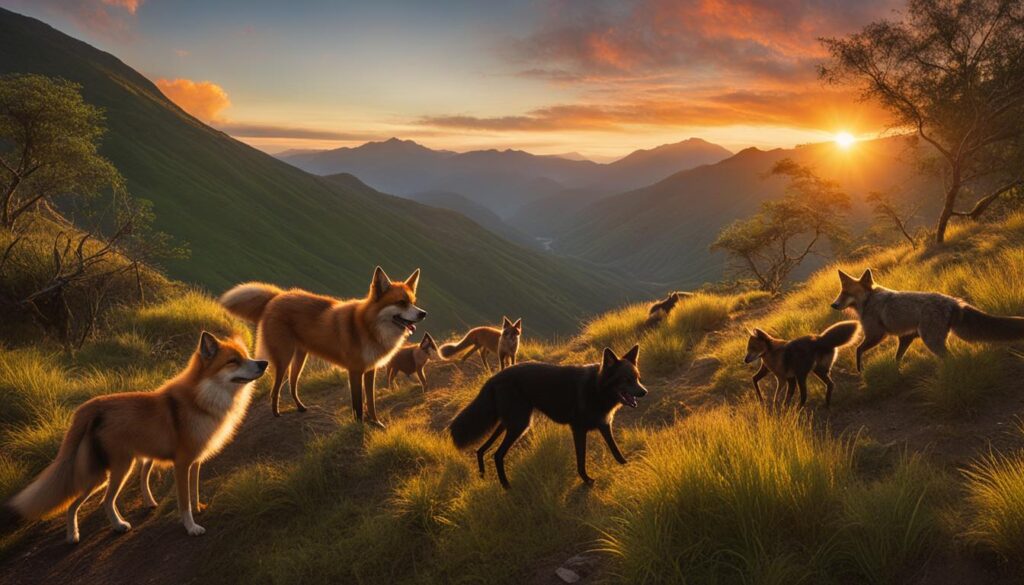
Dogs in South American Andes Expeditions: An Ancestral Puzzle
While the exact origins and connections between dogs and foxes in South America remain enigmatic, the intertwined history of these canines highlights the complexity and diversity of the region’s fauna and human interactions. Future studies may shed light on the genetic makeup of these animals, further unraveling the stories concealed within their DNA. By exploring the connection between dogs and foxes, we embark on a journey of discovery, tracing the footsteps of our ancestors and the rich tapestry of life in the South American Andes.
Unraveling the Mystery of El Dorado in South America
El Dorado, the legendary city of gold, has captivated the imaginations of explorers for centuries. It is said to be hidden somewhere deep within the uncharted interior of South America. Many expeditions have ventured into the treacherous Andean terrain in search of this mythical city, hoping to uncover its unimaginable riches. In these perilous journeys, dogs played a vital role, aiding explorers in navigating the challenging Andean terrain and guiding them toward their elusive goal.
The dogs’ role in the pursuit of El Dorado cannot be underestimated. They provided more than just companionship; their keen senses and intuition helped lead explorers through rugged mountains, dense forests, and treacherous rivers. With their acute hearing and sense of smell, these loyal canines detected danger, warned their human companions of potential threats, and guided them away from hazardous areas.
Furthermore, dogs were invaluable assets in the exploration of the Andes. Their stamina and agility allowed them to traverse difficult terrains that would have been nearly impassable for humans alone. They forged paths, found water sources, and located safe routes, ensuring the safety and survival of the entire expedition. Their unwavering loyalty and unwavering dedication to their human counterparts made them indispensable companions in the pursuit of El Dorado.
| Canine Assistance in Andean Expeditions | Functions |
|---|---|
| Navigation | Aided explorers in navigating challenging terrain |
| Early Warning System | Provided early warnings of potential dangers |
| Pathfinding | Located safe routes through treacherous areas |
| Resource Location | Found food and water sources in the wilderness |
While El Dorado may remain a myth, the expeditions undertaken in search of it have shed light on the significant role dogs played in South American Andes expeditions. The bond between humans and canines in these journeys showcases the remarkable partnership and mutual reliance between species in the pursuit of discovery and adventure. Without the guidance and support of these loyal companions, the exploration of the Andes, including the search for El Dorado, would have been far more challenging, if not impossible.

The Search for El Dorado: An Ongoing Quest
The quest for El Dorado continues to this day, captivating the curiosity of modern-day adventurers. While the mythical city may elude discovery, the legacy of the dogs that aided in Andean expeditions lives on. Their unwavering loyalty, courage, and invaluable assistance in navigating the challenging terrain of the South American Andes have left an indelible mark on the history of exploration. As we unravel the mystery of El Dorado, we gain a deeper appreciation for the profound connection between humans and canines in the pursuit of exploration and discovery.
Conclusion
Throughout South American Andean expeditions, dogs have been your loyal companions and trusted guides, ensuring your safety in the challenging terrain of the Andes Mountains. Their historical significance cannot be overlooked, as they have played a vital role in the success and survival of explorers like you.
These canines have accompanied you on your journeys, offering their unwavering support and protection. They have navigated the rugged mountain paths with their sharp senses and intuition, leading the way and helping you find safe routes.
The bond between humans and dogs in Andean expeditions highlights the remarkable partnership and mutual reliance between species. As you embark on your next adventure, remember the invaluable contribution of these canines and the historical significance they hold in the exploration of the Andes Mountains.
FAQ
Did dogs really play a crucial role in South American Andean expeditions?
Yes, dogs have been integral to Andean expeditions throughout history, serving as reliable companions and guides.
What roles did dogs fulfill in South American mountain exploration?
Dogs have assisted explorers in navigating the challenging terrain of the Andes, providing guidance, locating safe routes, and alerting to potential dangers.
What kind of dogs were used in Andean expeditions?
Initially, native peoples brought along domesticated dogs, and European explorers later introduced more gregarious and colorful domestic dogs to the region.
Are dogs and foxes related in South America?
The distinction between dogs and foxes in South America has been debated, but theories suggest that the Patagonian dog may have been a crossbreed between a domestic dog and a Culpeo “fox.”
What is El Dorado, and did dogs play a role in the expeditions to find it?
El Dorado is a mythical city believed to be located in the unexplored interior of South America. While dogs were not specifically involved in the search for El Dorado, their historical role in Andean expeditions provides valuable insights into the challenges explorers faced.
What is the significance of dogs in Andean expeditions?
Dogs have been invaluable companions and guides, assisting explorers in navigating the challenging terrain of the Andes Mountains and contributing to the success and survival of South American explorers.

